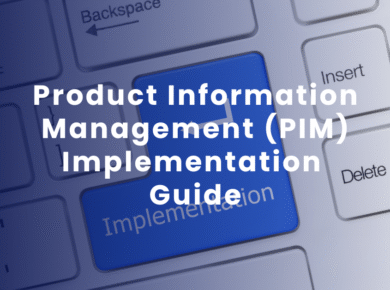How Will GenAI Redefine the Hybrid Shopper Experience? Read Blog Holiday shopping
As Thanksgiving nears and Black Friday promotions begin earlier each year, retailers and eCommerce leaders prepare for the rush. The 2025 holiday season is already looking different. According to Gartner (2025), 64% of U.S. consumers intend to complete most of their shopping before Black Friday. Nearly half will switch easily between online and in-store options.
The key issue isn’t just how to sell more; it’s how to work more efficiently. For retailers managing the time from Thanksgiving to New Year, unified data may be what sets them apart from those who get overwhelmed by demand.
The Cost of Disconnected Data
Many retail businesses still deal with separate systems. Product data is kept in one place, customer information is in another, and inventory records are in spreadsheets. This leads to mismatched product details, slow responses, and a poor experience for shoppers.
Imagine this: a customer sees a “holiday exclusive” online at a discount for Thanksgiving weekend, but the store associate cannot find the same promotion or availability. That one inconsistency can quickly break trust. When leaders cannot see real-time performance across channels, they waste valuable time making pricing or inventory decisions during the busiest days of the year.
Why Unified Data Matters for Holiday Readiness?
A unified data ecosystem, or data fabric, connects every operational and customer-facing element in real time. It links product information, customer data, marketing analytics, and fulfillment systems into one living framework.
When a CMO can see updated inventory data instantly, promotions become more precise. When a CTO notices early demand patterns, infrastructure can grow proactively. When CX teams have complete visibility into customer journeys, they can personalize engagement confidently.
According to McKinsey (2025), retailers using integrated data management platforms are 32% faster at changing campaigns during busy periods. This flexibility helps them use data to gain real benefits, such as launching targeted promotions, reallocating inventory, or re-engaging lapsed customers before the chance passes.
PIM as the Backbone of Consistency
Product Information Management (PIM) plays a crucial role in keeping data accurate and consistent at every customer touchpoint. It brings together all product details, including specifications, pricing, and digital assets. This makes it easy to publish the information across websites, marketplaces, and physical stores.
When a customer compares products across different channels, this consistency builds confidence. It reduces confusion, boosts sales, and lowers returns caused by incorrect information. When PIM integrates smoothly with existing data management systems, brands achieve both operational efficiency and customer trust.
Moving from Reactive to Predictive Operations
Data maturity in 2025 isn’t just about storage or access. It’s about foresight. Unified data enables predictive intelligence that helps retailers anticipate demand and adjust instantly.
- Predictive Demand Forecasting helps identify which product categories will increase during New Year sales. This ensures that inventory is ready.
- Personalized Offers can target early Black Friday shoppers with tailored recommendations based on their browsing intent, rather than just demographics.
- Dynamic Pricing Models adjust prices in real time based on supply, demand, and competitor actions across multiple channels.
Retailers using GenAI in their data systems can simulate scenarios, spot anomalies, and suggest next steps much faster than manual analysis can.
Building Omnichannel Experiences That Feel Effortless
Unified data supports a smooth omnichannel experience, which customers now expect. A shopper browsing a Thanksgiving deal online wants to confirm if it is available for in-store pickup. Another shopper may add items to their Black Friday cart via mobile and complete their checkout in a physical store. When systems share the same trusted data, these experiences feel seamless, and customer loyalty grows.
CMOs and CX heads can then focus on engagement instead of troubleshooting. Reliable data builds trust, and trust drives repeat business well into the New Year sales cycle.
Practical Steps for Retail Leaders
To gear up for the upcoming holiday rush, technology and business leaders should focus on:
- Mapping Data Flows: Find out where product, customer, and inventory data are located and where they disconnect.
- Integrating PIM and Core Systems: Ensure product and customer data sync instantly across eCommerce, CRM, and POS platforms.
- Real-Time Visibility: Set up unified dashboards for sales, logistics, and campaign tracking.
- Embedding GenAI Models: Use AI to predict outcomes, automate insights, and improve promotions dynamically.
This setup empowers teams to act clearly during key events like Black Friday and New Year’s Eve sales, where a quick response can directly affect revenue.
Key Takeaways
- Unified data drives agility: Retailers with connected systems across product, customer, and supply chain can react up to 30% faster during busy times like Thanksgiving and Black Friday.
- PIM ensures consistency: Centralizing product information reduces return rates and builds trust when shoppers move between online and in-store experiences.
- Omnichannel visibility improves CX: Real-time synchronization between eCommerce, CRM, and POS systems ensures customers see accurate pricing and stock information, which is crucial for loyalty during New Year sales.
- GenAI turns insights into action: AI-powered forecasting helps predict demand, personalize offers, and adjust campaigns dynamically.
- Holiday readiness means data readiness: Retail success this season depends less on bigger discounts and more on reliable, unified data that supports every decision.
Is your retail data ecosystem ready for this holiday surge? Connect with Innowinds to unlock unified data, smarter CX, and GenAI-driven growth this season.
Latest Resources
How Unified Data Can Keep You Ahead This Holiday Read Blog As
Enterprise Data Management in Transition: 2026 Trends and AI-Driven Shifts Read Blog
Unlocking Growth: Why PIM DAM Integration Is a Strategic Imperative Read Blog
Mastering Product Data Syndication: A Business-Centric Approach Read Blog Why Accurate Product
The Hidden Costs of Missing Metadata in Digital Asset Management Read Blog
Key Takeaways: Identify the Right Time for PIM: Gain clarity on identifying
PIM vs MDM: What’s the Difference and When to Use Each? Read
Questions to Ask When Choosing a PIM Vendor? - Part 2 Read
Questions to Ask When Choosing a PIM Vendor? - Part 1 Read









